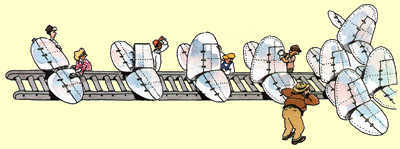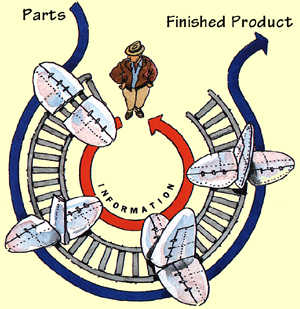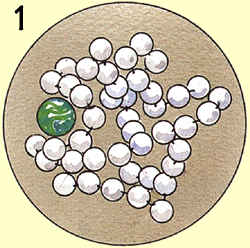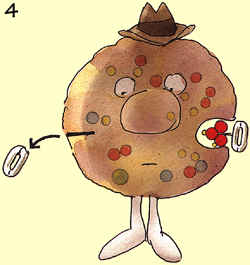|
|
| The
workers' assembly rate of airplane tails is satisfactory; the supervisor
is content. |
 |
| The
tails are not being used as fast as they're made and they begin
to accumulate; the supervisor takes note. |
 |
| The
supervisor calls for a slowdown. The inventory of finished tails
decreases as workers slow production. Later, as the supply of tails
falls, the supervisor signals the workers to speed up their rate
of assembly. |
 |
|
 |
Lines
and Loops
An assembly line moves in one direction only - from input of raw materials
to output of product, with the supervisor acting as the governor,
or controlling agent. If too much product begins to accumulate, the
supervisor slows down the input of raw materials. Conversely, if there
are too many raw materials, the supervisor speeds up production. |
|
| To appreciate
how feedback works, it helps to imagine the information (the signals that
say "too much" or "not enough") as flowing in a loop. Bending the production
line into a circle and stationing the supervisor at a strategic point point
overseeing both input and output gives him or her greater control. This
arrangement is impractical for many factories, but it works beautifully
inside cells, in molecular assembly lines like the one shown below. |
 |
 |
|
In a negative feedback loop, information flows in a circle, which
is central to controlling the rate of assembly. A single supervisor
is the key to the information loop's continuity. |
Here are four enzymes making an amino acid.
|
|
 |
 |
 |
The first enzyme - the supervisor - notes an excess build-up of the
amino acid.
|
He stops the assembly line and waits for inventory to drop. |
When the amino acid level is low
enough, he starts the line again. |
|
Enzyme
Governors
We
can now better appreciate why we call enzymes "smart."Their unique
chemical character gives them the ability to do their usual work
of rearranging or disassembling other molecules but also to process
information. Certain supervisory, or regulatory, enzymes do this
by readily and reversibly changing shape in response to a
signal. In addition to the working site on their surface where other
molecules "dock" to get processed, regulatory enzymes have a second
site specifically designed to hold a small signal molecule. Nestled
in this special niche, the signal molecule acts like a finger on
an on/off switch: It causes the enzyme to modify its shape so that
its working site stops functioning. Allostery (literally "other
shape"), the name given to this almost ridiculously simple behavior,
underlies most of the unimaginably complex regulatory processes
of life. |
 |
 |
Imagine a tightly balled string of beads
surrounding a marble. |
Now imagine pushing your finger into the beads on the side opposite
the marble, causing the beads to shift. |
 |
 |
As your finger moves into its niche,
the marble pops out. |
Regulatory proteins behave in a similar way. When a signal molecule
enters one site it it changes the function of another site. |
|
|
|















